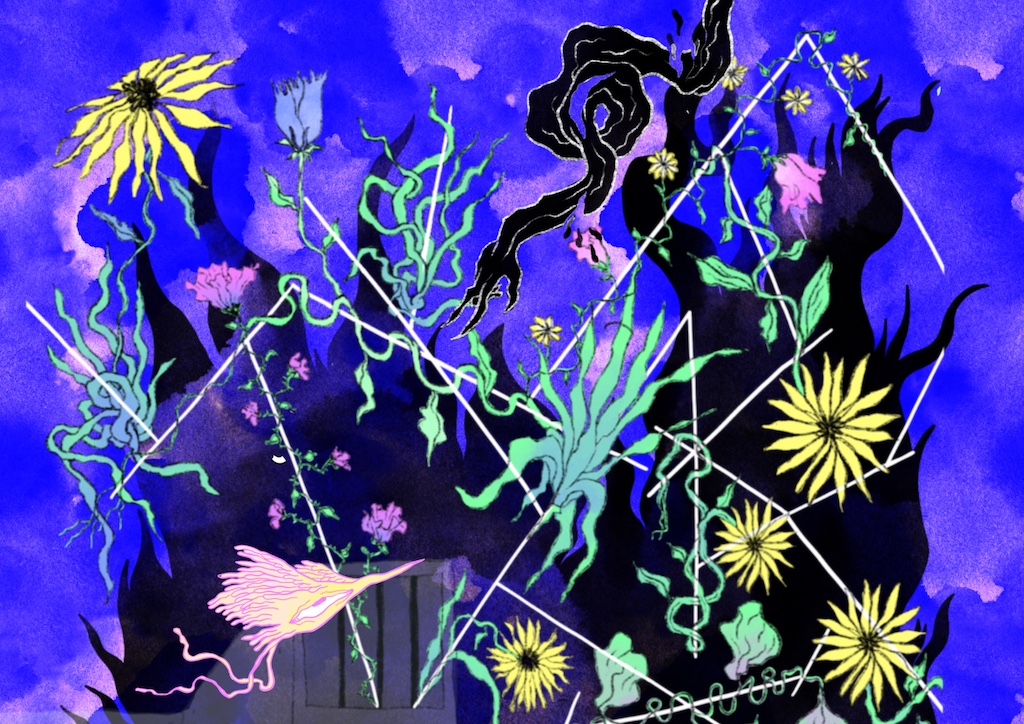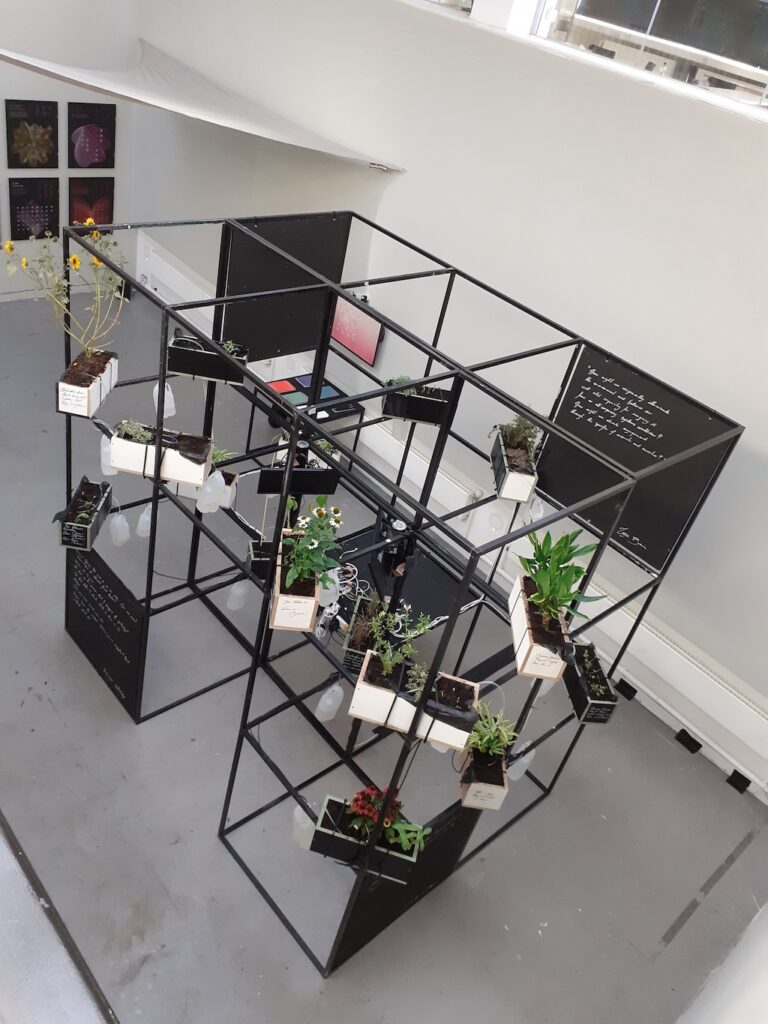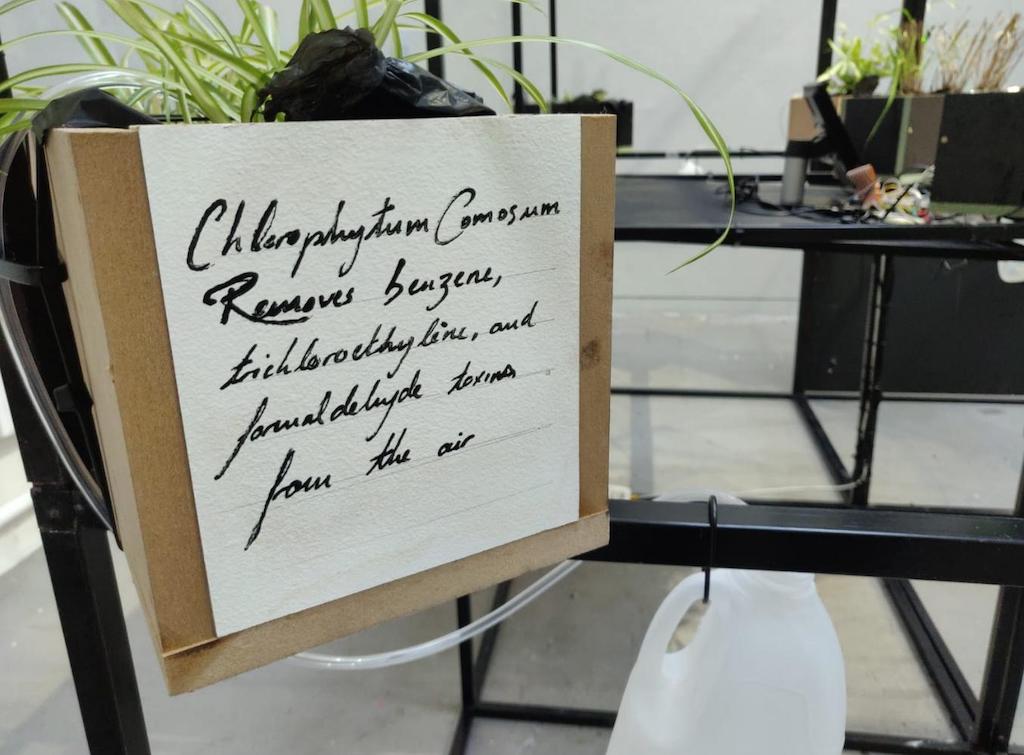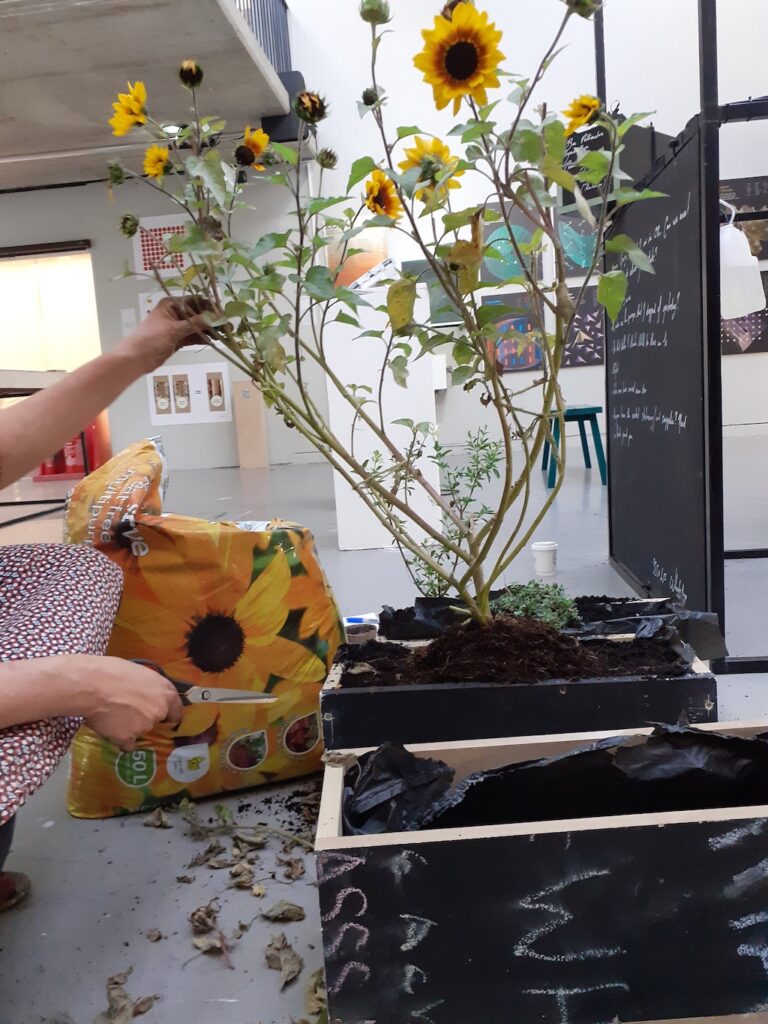
What does the trouble look like when it comes, and what happens afterwards? Voss and Verhoeven reflect on the life and aftermath of a botanical project, where plants, electronics and reflections on institutional life transformed into pests, rot and lockdowns.
After the festival ended, we dismantled the installation—a bio-infrastructure composed of flora and electronics and redistributed the component parts around the building. We gave some of the planters—wooden boxes filled with earth and plants—to our colleague C, whose teaching studio was located in an eaves room with huge slanted windows. The seals on the window frames were disintegrating and, when it rained, water leaked through. It seemed serendipitous, allowing the troubled state of one assemblage to nourish the growth of another–what our project had been about all along.
A few weeks later, C came back to us. The plants were doing well but something was rotting in the humus below, attracting flies. Everyone liked the plants, but the insects were a problem.
Stay with the trouble, we are encouraged, but what does trouble look like when it comes? What if it’s not what we’re expecting?

In Autumn 2019, our critical practice group Supra Systems Studio (SSS) built the botanical infrastructure, “Obtrusive Relationships,”1 for London Design Festival. Our aim was to explore the complex socio-technical systems that we live in and challenge how we think about them. In her essay “The Environment Is Not a System,” Tega Brain describes how computational systems thinking frames the perception of the natural environment as something discrete, functional, controllable2. This perspective encourages a solutionist approach, denying complexity or collectivity, while framing itself as a neutral tool for modeling3.
SSS is located in the Design School at London College of Communication (LCC), University of the Arts London—a nested set of institutional relationships and dependencies. In “Obtrusive Relationships” we wanted to highlight the ‘trouble’ of these institutions and the physical places they inhabit—inefficiencies, leakages, pollution, heating run-offs, food waste and more. Rather than building something to ‘solve’ human-centered problems4, we wanted to draw attention to how all of these institutional, technical and ecological systems were interconnected.
The piece consisted of two large grid structures built from metal frames, each containing ten planters.5 Each structure contained a self-adjusting watering system comprising moisture sensors, tubing, electronics and water tanks. The design and construction used extant and waste materials from inside LCC: the frames were a reusable exhibition structure; the planters were built from wood off-cuts from the 3D workshops; coffee grounds from the café were used as fertilizer; and empty plastic bottles from the kitchens were turned into water containers.
The college sits on a large roundabout, which thousands of road vehicles pass through each day, pumping out air pollution, damaging living ecosystems—from causing lung damage, to confusing insect pollinators. Our plants were chosen to counteract these harms—some selected for their phytoremediation, others for their insect pollinating properties. 6

We wanted to emphasize that we were part of the work, making aesthetic and functional choices informed by our human capacities and values. The technically-skilled studio members wrote code and built the electronic infrastructure. One colleague with elegant handwriting was tasked with writing the planter labels and quotes from texts that we had found to be thought-provoking.
Similarly, we couldn’t vanquish human expectations around time that exist within institutions. Plants don’t grow according to exhibition schedules or funding cycles, nor do they detoxify air and soil in one measurable moment. An institution is not an overstory.7 We had all seen botanical artworks installed for lengthy exhibitions, purporting to center more-than-human life, filled with dying saplings and weedy, undernourished plants. Our bio-infrastructure worked against anthropomorphic measures of time, so we needed to re-conceptualize how long the installation lasted. We looked after the plants in our homes so they could flourish before bringing them into the college. After the festival ended, we redistributed them to colleagues, to care for.
In this way, although the installation was only formally installed for two weeks, its duration was far longer – from early planning discussions, to picking culvers from lawns, to talking to colleagues about the work; through de-installation, recycling, returning the constituent materials of the structure, and distributing the planters. All along, it spurred discussion about what a human de-centered practice might look like in a complex institutional setting and the tensions that came with it.
The rain fell. The insects came, both intended and unintended. And then, six months later, the pandemic arrived and everything shut down.
Looking back on “Obtrusive Relationships” almost four years on gave us the opportunity to think differently about the work and our expectations of it and ourselves. We’d intended to create work around the porousness of institutions, the interconnectivity of all things, and different forms of time, as a way of sidling alongside the different forms of friction that exist within systems. However, we also inadvertently introduced our own bounded expectations of how these systems should behave. We expected bees, not flies. We anticipated the academic year to roll round again, as usual, not for the building to close as a pandemic emerged. The metal grids sat in storage for several years, as student shows shifted online.
We talk of staying with the trouble, of living with uncertainty, of, as Donna Haraway writes, existing within “still possible pasts, presents, and futures.”8 But in thinking about systems, we should also think about the unexpected. Systems, Donella Meadows reminds us, are surprising—all of those knotted interconnections throw strange, unexpected, and sometimes unwelcome, things into our paths.9 We wanted the project to exist within what Arturo Escobar describes as the “ceaseless flow of life,”10 and indeed, life kept on coming.
If, as Cecilia Åsberg and Marietta Radomska write, post-human feminist analytics ultimately deal with change and the relations that that make a situation possible,11 then we should be ready for surprises. Drawing attention to the presence of complex assemblages is one thing, but experiencing change in those systems allows us to feel when and how those relational structures flex and flux – and, crucially, how vulnerable we are within them.
From the rot that draws the insects to the metal frames locked in cupboards, these moments puncture our expectations of how a thing should be, jolting us out of time and into the space of these complex worlds.

Georgina Voss is an artist, writer, and educator. Her work explores the presence and politics of large-scale technologies, heavy industry, and complex systems through performance, multi-media installations, writing, and research. She is author of the forthcoming book, ‘Systems Ultra’, (Verso, 2024) and co-founder and lead of Supra Systems Studio, UAL.
Eva Verhoeven is Programme Director for Creative Computing & Robotics at the Creative Computing Institute, UAL; and co-founder of Supra Systems Studio. She works at the intersections between design, art, research, and teaching, using interdisciplinary critical and creative practice to investigate the interfaces of ecological, political and technical systems.
- For ‘Obtrusive Relationships’: Gareth Foote, Wesley Goatley, Marion Lagedamont, Alistair McClymont, Tobias Revell, Oliver Smith, Eva Verhoeven, Georgina Voss ↩︎
- Brain, Tega. “The Environment Is Not a System.” A Peer-Reviewed Journal About 7, no. 1 (July 6, 2018): 152–65. https://doi.org/10.7146/aprja.v7i1.116062. (quote from p153) ↩︎
- See, for example: Forlano, Laura. “Posthumanism and Design.” She Ji: The Journal of Design, Economics, and Innovation 3, no. 1 (2017): 16–29. https://doi.org/10.1016/j.sheji.2017.08.001. ↩︎
- Flusser, Vilém. “Vom Wort Design.” In Vom Stand Der Dinge, 9. Steidl Verlag, 1993.; Flusser, Vilem, and John Cullars (translator). “On the Word Design: An Etymological Essay.” Design Issues 11, no. 3 (1995): 50. https://doi.org/10.2307/1511771. ↩︎
- Inspired by Rashid Johnson’s 2016 work, “Antoine’s Organ,” the piece was big: each of the two parts of the installation were large enough to walk around inside. ↩︎
- These plants included: Brassica juncea (Indian mustard), which can absorb cadmium, selenium, and lead from the soil; Dracaena deremensis, which absorbs benzene from the air; and Helianthus annuus (common sunflower) which absorbs heavy metals from the soil, including lead, zinc, and nickel, while the flowers attract bees and other insects, and edible seeds provide food for birds. ↩︎
- We were familiar with these limits: in an SSS installation at the V&A the previous year, “Office Rites” (2018), we had been instructed not to bring any soil in because it would act as a contaminant into the gallery space where our work was being shown. ↩︎
- Haraway, Donna Jeanne. Staying with the Trouble: Making Kin in the Chthulucene. Experimental Futures: Technological Lives, Scientific Arts, Anthropological Voices. Durham: Duke University Press, 2016. ↩︎
- Meadows, Donella H., and Diana Wright. Thinking in Systems: A Primer. White River Junction, Vt: Chelsea Green Pub, 2008. ↩︎
- Arturo Escobar, ‘Design for Transitions’, in Designs for the Pluriverse: Radical Interdependence, Autonomy, and the Making of Worlds, Duke University Press, 2018, 146. ↩︎
- Åsberg, Cecilia, and planetary Radomska. “Why We Need Feminist Posthumanities for a More-than-Human World.” Transformative Humanities (blog), August 23, 2019. https://www.kth.se/blogs/hist/2019/08/why-we-need-feminist-posthumanities-for-a-more-than-human-world/. ↩︎
